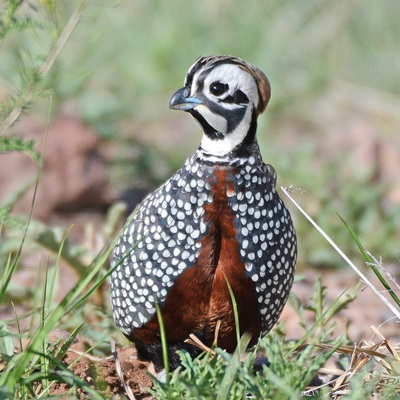What is a quail?
1. a small, short-tailed Old World game bird resembling a small partridge, typically having brown camouflaged plumage.
2. a small to medium-sized New World game bird, the male of which has distinctive facial markings.
Old World Quail
Old World quail are small ground dwelling game birds that are native to Europe, Africa, Asia and Australia. They are in the family, Phasianidae, which includes chickens, pheasants, partridges, turkeys and peafowl.
Japanese Quail
Other Names: Coturnix quail
Incubation Period: 16-17 Days
Maturity: 8 weeks (2 months)
Description: The Japanese quail was first domesticated nearly 1,000 years ago and has a long history with humanity. This species plays a major role in the food industry and scientific research. The Japanese quail has been bred for meat and eggs through artificial selection. Domestic birds are much larger and lay more eggs than their wild counterparts. Japanese quail are abundant in their wild range.
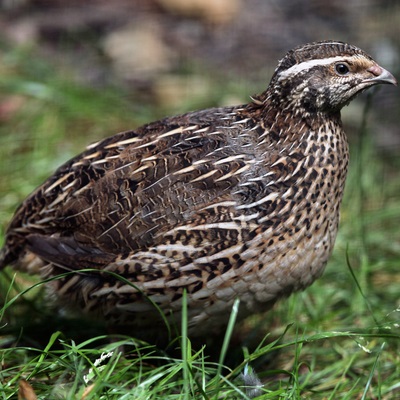
Statistics
Rarity: Common
Ease of Care: Beginner
Tameability: High
Egg Production: High
King Quail
Other Names: Button quail, Chinese painted quail, Blue-breasted quail
Incubation Period: 16-17 Days
Maturity: 8 weeks (2 months)
Description: The King quail is the smallest Old World quail. It has been domesticated for aviculture due to its easy-going nature and compatibility with other birds. King quail are available in several colour mutations and are commonly kept on aviary floors as a cleanup crew. This tiny quail is a prolific layer of miniature eggs.

Statistics
Rarity: Common
Ease of Care: Beginner
Tameability: Moderate
Egg Production: High
New World Quail
New World quail are small to medium sized game birds that are terrestrial or arboreal. They are native to North and South America. They are in their own family, the Odontophoridae, and are only distantly related to Old World quail. Most species exhibit strong sexual dimorphism and males are more brightly coloured.
Northern Bobwhite
Other Names: Bobwhite quail
Incubation Period: 23-24 Days
Maturity: 24 weeks (6 months)
Description: The Northern Bobwhite is named after the male's whistled "bob-white" call. This species has a long history as an American game bird and has been extensively researched in habitat management studies. Bobwhites have been in sharp decline throughout the past half-century, likely owing to habitat loss and changes in agriculture. They are an increasingly high priority for conservation.
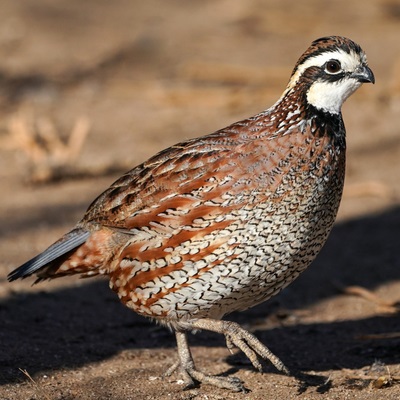
Statistics
Rarity: Common
Ease of Care: Beginner
Tameability: Moderate
Egg Production: High
California Quail
Other Names: California valley quail, Valley quail
Incubation Period: 22-23 Days
Maturity: 24 weeks (6 months)
Description: The California quail has an iconic crest made of six feathers that droops forward, black in males and brown in females. This species is the state bird of California and is the most commonly portrayed quail species in popular media.

Statistics
Rarity: Uncommon
Ease of Care: Intermediate
Tameability: Low
Egg Production: Moderate
Gambel's Quail
Incubation Period: 22-23 Days
Maturity: 24 weeks (6 months)
Description: The Gambel's quail is a close relative of the California quail. The two can be easily distinguished as the Gambel's quail has reddish head feathers and lacks the scaly breast pattern. The Gambel's quail is a true desert resident and can withstand intense heat and drought. With enough fresh vegetation in its diet, Gambel's quail are able to go long periods of time with no water.
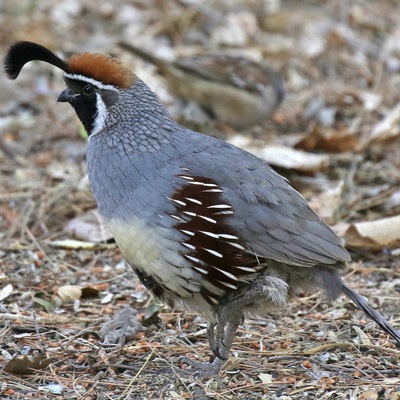
Statistics
Rarity: Uncommon
Ease of Care: Intermediate
Tameability: Low
Egg Production: Moderate
Scaled Quail
Other Names: Blue scaled quail, Blue quail
Incubation Period: 22-23 Days
Maturity: 24 weeks (6 months)
Description: The Scaled quail is named for the scaly appearance of its breast and back feathers. They are also easily identified by their white crest that resembles a tuft of cotton.
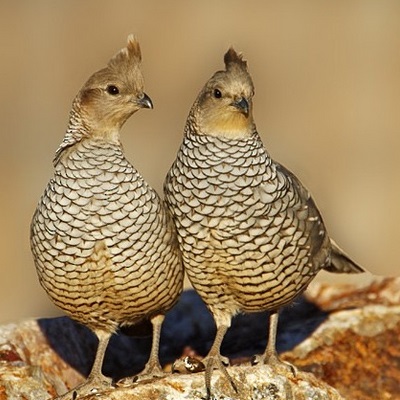
Statistics
Rarity: Uncommon
Ease of Care: Intermediate
Tameability: Low
Egg Production: Moderate
Elegant Quail
Other Names: Benson quail, Douglas quail
Incubation Period: 22-23 Days
Maturity: 24 weeks (6 months)
Description: The Elegant quail is native to the Pacific-slope thorn forest of north-western Mexico. Males can be identified by their gold-orange crest while the female's crest is grey.
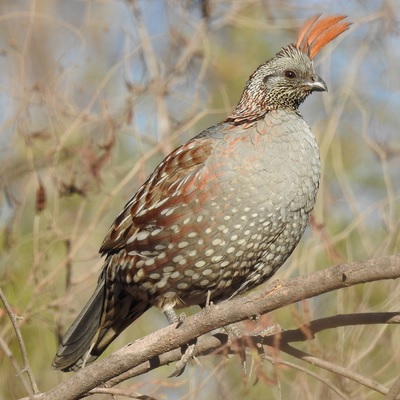
Statistics
Rarity: Rare
Ease of Care: Advanced
Tameability: Low
Egg Production: Low
Mountain Quail
Incubation Period: 24-25 Days
Maturity: 24 weeks (6 months)
Description: The Mountain quail is the largest quail in North America. It sports a tall, pointed crest that consists of two feathers. The mountain quail has a unique nesting strategy where the female will lay two clutches in two separate nests. She will incubate one nest while her mate incubates the other.

Statistics
Rarity: Rare
Ease of Care: Advanced
Tameability: Moderate
Egg Production: Low
Montezuma Quail
Other Names: Mearns quail
Incubation Period: 25-26 Days
Maturity: 24 weeks (6 months)
Description: The Montezuma quail is a very secretive species that prefers to crouch in hiding rather than fly when disturbed. They are rarely seen due to their cryptic nature. Montezuma quail are equipped with large sickle-shaped claws which help them dig for their food. Despite being native to Southern states and Mexico, the Montezuma quail is actually more closely related to the wood-quail of South America.
